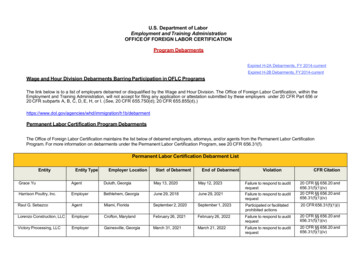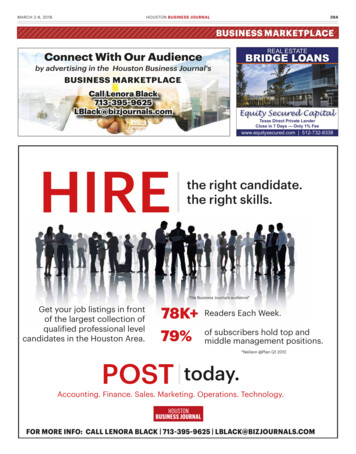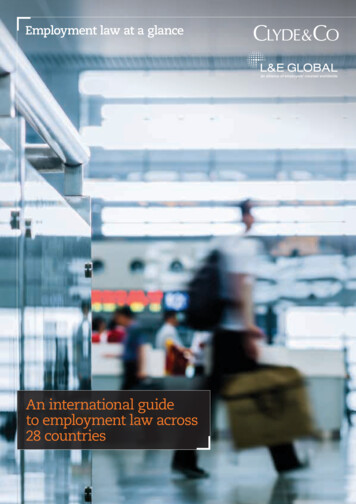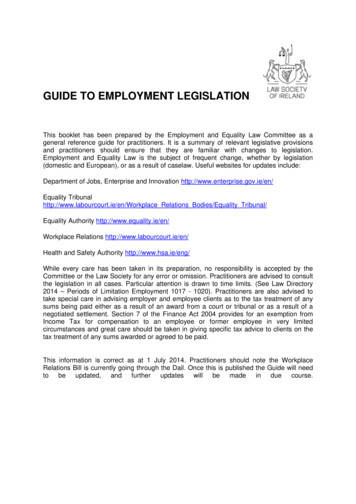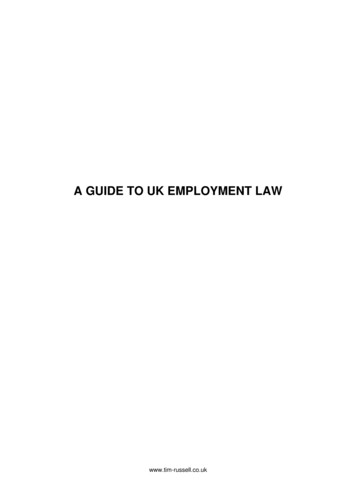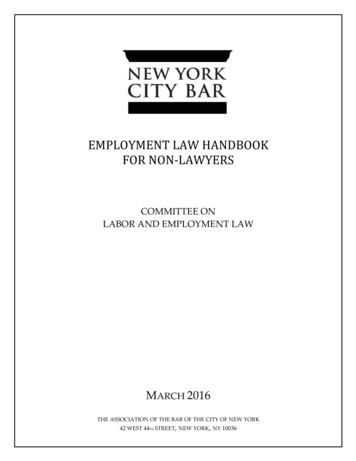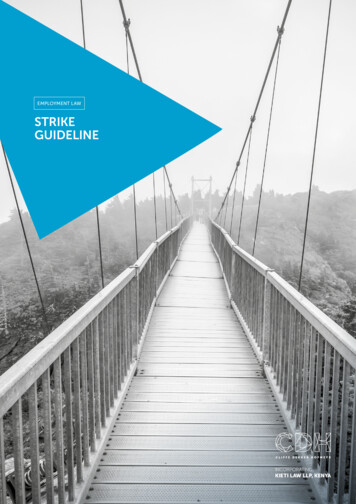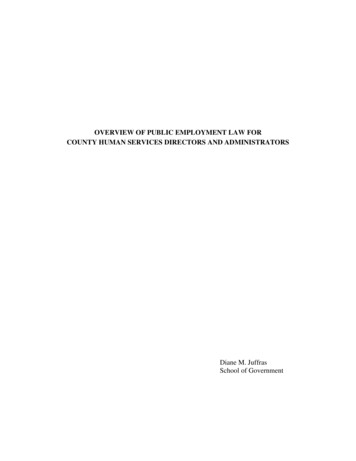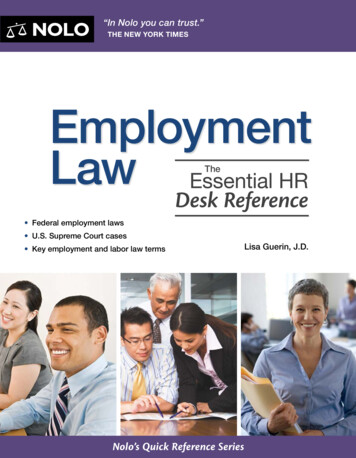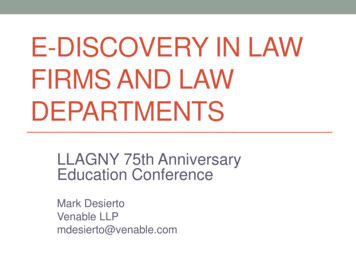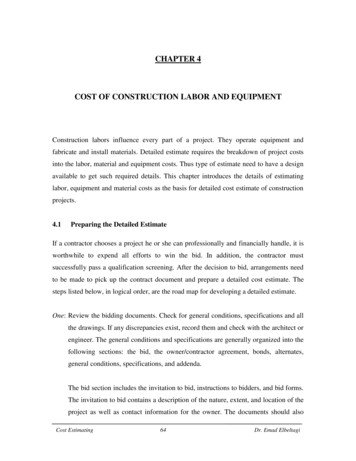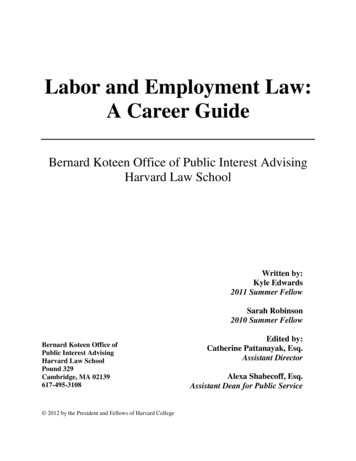
Transcription
Labor and Employment Law:A Career GuideBernard Koteen Office of Public Interest AdvisingHarvard Law SchoolWritten by:Kyle Edwards2011 Summer FellowSarah Robinson2010 Summer FellowBernard Koteen Office ofPublic Interest AdvisingHarvard Law SchoolPound 329Cambridge, MA 02139617-495-3108 2012 by the President and Fellows of Harvard CollegeEdited by:Catherine Pattanayak, Esq.Assistant DirectorAlexa Shabecoff, Esq.Assistant Dean for Public Service
Table of ContentsAcknowledgements . 3Chapter 1: Introduction . 4Chapter 2: Issue Areas . 8Chapter 3: Practice Settings . 12Chapter 4: Work Types . 25Chapter 5: Planning Your Career . 29Chapter 6: Extracurriculars . 45Chapter 7: Personal Narratives . 48Chapter 8: Selected Organizations . 55Chapter 9: Selected Fellowships . 73Chapter 10: Selected Websites . 812
AcknowledgementsThis guide would not have been possible without the thoughtful insights gathered through nearly40 interviews with labor and employment attorneys. Profound thanks are due to the followingindividuals for sharing their personal stories and rich knowledge of the field: Robin Alexander,Alison Asarnow, Steve Berzon, Cathleen Caron, Robert DeGregory, Elizabeth Drake, EdwardEitches, Terri Gerstein, Chuck Gilligan, Norm Gleichman, Shelley Gregory, Aaron Halegua,Piper Hoffman, Laura Juran, Lela Klein, Sophia Lai, Cyrus Mehri, ReNika Moore, ClairePrestel, Jose Rodriguez, JJ Rosenbaum, Sasha Shapiro, Hara Sherman, Summer Smith, DougStevick, Ashwini Sukthankar, Judith Starr, Julie Su, Anand Swaminathan, Daniel Vail, GraysonWalker, and Michelle Yau.We are particularly grateful to Patricia Kakelec, Greg Schell and Shannon Liss-Riordan, forproviding personal narratives, and to Claire Prestel for both being interviewed and reviewing thelabor sections of the guide respectively.We also drew from a wonderful panel presented by the National Association of Law Placement’sPublic Service Section in October 2011 called “Putting a Law Degree to Work for Workers: TheNew Landscape in Labor & Workers’ Rights Careers” featuring Dovie King, Ricardo Ochoa andLiza Zamd.Many thanks to Professor Ben Sachs for contributing his expertise in labor and employment lawin editing this guide. Much gratitude is due to Catherine Pattanayak and Kirsten Bermingham fortheir careful editing and spot-on comments. Finally, thanks to Alexa Shabecoff for envisioningthis guide and seeing it through to the finish with thoughtful editing and supervision.3
1CHAPTERINTRODUCTIONThere is something fundamental to a person’s identity about work. “People’s jobs are theirlives,” says Claire Prestel ’02, a staff attorney for Public Justice who previously worked for theService Employees International Union (SEIU) and the labor and civil rights firm AltshulerBerzon. “It gives you your sense of who you are as a person, your sense that you are contributingto society. Anyone who has been laid off or spent a period of time involuntarily unemployedknows how bad that feels.” Work allows us to pay the bills, but is also a fundamental outletthrough which we express ourselves to the broader community. Work defines our daily scheduleand also shapes our future aspirations.It follows that workplace issues, which exist in all regions and sectors across the world, are oftenmicrocosms of larger community problems. Shelley Gregory ’01, formerly Senior StaffAttorney at the Legal Aid Society Employment Law Center, notes that, “People bring all of theirideas, their beliefs, their perceptions, and their ways of making sense of the world into theirworkplace with them.” She goes on to explain that, “Our workplaces are much more regulatedthan our homes. There is a lot that goes on in the workplace that really has a serious effect onpeople’s lives.” As a result, working in labor and employment law enables lawyers to make anoticeable and widespread difference in society. This guide will introduce you to some of theopportunities that can help you build a lasting, rewarding career in this field.LABOR AND EMPLOYMENT LAW: AN OVERVIEWLabor law has traditionally encompassed the relationships among unions, employers, andemployees. Labor laws grant employees in certain sectors the right to unionize and allowemployers and employees to engage in certain workplace-related activities (for example, strikesand lockouts) in order to further their demands for changes in the employer-employeerelationship.Employment law, on the other hand, is defined more broadly as the negotiated relationshipsbetween employers and employees. Although employment lawyers deal with many of the sameparties as labor lawyers (i.e., workers and companies), they conventionally address issues thatfall outside the framework of union-management relations and collective bargaining. As a result,the extent to which statutes or regulations pertain to unions and union-workers usuallydetermines whether or not they are regarded as components of “labor law” or “employment law.”Given the distinguishable set of issues encompassed in each field, labor law and employment lawremain discrete areas of practice. However, these two fields have, over time, becomeincreasingly symbiotic. Careers in either field can involve both labor and employment lawquestions. This guide will give you a better sense of the major differences between the two areasso that you are better able to define your particular interests.The labor and employment law fields are constantly evolving. Since workplaces often changefaster than the laws that govern them, attorneys must regularly rethink how these fields should4
look in the present and in the future. Greg Schell ’79, Managing Attorney of the MigrantFarmworker’s Justice Project at Florida Legal Services, notes that “The human mind isenormously creative—by the time you close a loophole that had previously allowed employers tonot uphold the legal rights of employees, they find a new one. The schemes and scams seemendless.” Some of the most current and controversial issues in labor and employment lawinvolve collective bargaining, discrimination, wage and hour regulations, immigration issues,health care benefits, and pension security.WHY WORK IN LABOR OR EMPLOYMENT LAW?This guide is written from the perspective of those public interest lawyers who work on behalf ofunions and employees, as opposed to the large number of labor and employment lawyers whorepresent the management side of disputes.Impact on WorkersThe employer-employee relationship involves complex power dynamics. Shannon LissRiordan ’96, founding partner of Lichten & Liss-Riordan, P.C., a plaintiffs’-side employmentand union-side labor law firm, laments that “the balance between employers and employees isgrossly disproportionate.” In explaining why labor and employment lawyers are so necessary,Claire Prestel ‘02 notes, “No one employee can stick their head up and complain without fear ofretaliation. Anyone in any workplace knows how that works.” In the face of staggering amountsof illegal retaliation, lawyers are needed “to make workers’ rights real and to give them thecourage to stand up in the future.”In distinguishing labor and employment law from other public interest fields, Laura Juran, anin-house attorney for the California Teachers Association, explains, “There is an immediacy to itthat I just think is different. You are not dealing with impact litigation where you have somenamed plaintiff but it’s just kind of a plaintiff in theory. There is a real person in front of youwho is crying and has had a terrible thing happen and you are there to help them. Some of themost satisfying cases I’ve handled as a labor lawyer are the cases where I get someone their jobback and save their family’s livelihood.”The majority of lawyers interviewed for this guide echoed Juran’s emphasis on working face-toface with real people from a variety of different occupations. Anand Swaminathan ’06,formerly with Vladeck, Waldman, Elias, & Engelhard, a union-side labor firm, and now withLoevy and Loevy, a civil rights firm in Chicago, remarks, “These people come in everyday. Iknow their faces, I know their names, and I know about their problems. I spend a lot of timeinteracting with them directly so that I know and understand who I’m working for and who I’mrepresenting.” If this type of interaction appeals to you, labor and employment law is a field thatallows, and indeed is based on, such interpersonal exchanges.Nationwide ImpactOn a larger scale, Claire Prestel ’02 notes that unions serve a function rarely perceived orappreciated by law students: “Corporations and big banks and all of these entities, they have a5
huge and growing amount of sway. You need a counterbalance and Congress can’t be thatcounterbalance because they get their money from the corporations. If you have unions, theyrepresent thousands of employees. That’s the other side.” Laura Juran adds, “The unions arestill the groups that can get out thousands of people on a day’s notice to vote on an issue Ireally feel like we’re also protecting the middle class and middle class interests.” Anunderstanding of the role that unions play in our society is essential, especially in light of currentevents: in May 2011, Wisconsin, one of the first states toMy clients are great people and Iprovide collective bargaining for public sector workers,have been blessed and privilegedofficially revoked almost all of those rights. A number ofto represent them.states appear to be moving in that direction.- Greg Schell ’79Labor and employment law also provides an opportunityMigrant Farmworkerto help increase access to the justice system forJustice Projectdisenfranchised individuals across the country. ShelleyGregory ’01 notes, “I have found a way to take theeducation that I received at Harvard Law School and the access and the privilege and the benefitsof being educated at a place like HLS and I’ve been able to use that to facilitate access to thejudicial system or to systems that have the ability to provide real remedies to real live peoplewho, in the absence of the work that we’re doing, might not have access to agents of authority.”Similarly, Greg Schell ’79 explains that the people labor and employment lawyers represent are,“generally poor and they’re poor frequently because of the legal processes that our legal systemsupports.” Working as a labor or employment lawyer can allow you a hand in altering these legalprocesses.The Scope of the FieldThe vagueness of the term “labor and employment law” can deter law students and attorneyswhen considered alongside easily definable fields that may sound more exciting, such asenvironmental law, education law, and health law. Yet labor and employment law is truly aversatile field that frequently touches on issues that arise in a wide range of other legaldisciplines.Consider the career path of Robert DeGregory ’04. After graduating from HLS and clerking, heworked as an in-house attorney in the Pittsburgh office of the United Steelworkers, a unionwhich represents workers in a diverse range of industries, such as steel, paper and forestry, tireand automotive, other types of manufacturing, oil and gas, health care, and pharmaceuticals.Much of his work in this position consisted of providing legal support to the union in negotiatingcollective bargaining agreements which regulated the rights, benefits and entitlements of workersfor various companies, as well as enforcing the terms of those agreements through arbitrationand litigation. A major concern was to protect the benefits, health insurance, and pensions thatunion members “worked for many years at often difficult and dangerous jobs” to obtain. Fromthere he moved to Los Angeles to work for the Writers Guild of America, representing unionmembers in the film and television industry who work largely independently, often for manydifferent employers over their career. They do not have “just cause protection” from dischargealthough they are guaranteed minimum compensation under their individual contracts pursuantto the major multiemployer collective bargaining agreement the Guild negotiates and enforces6
with major studios and independent producers. Issues included enforcing guaranteedcompensation under individual agreements, ensuring back-end compensation for successfulmovies or shows, and handling intellectual property disputes over the rights of writers to controland be compensated for further exploitations of their original creative work. A somewhatwhimsical-sounding example of such an intellectual property dispute, which nonetheless couldhave a substantial effect on a writer’s legal rights and entitlement to compensation, would be todetermine “whether or not a toy that is being sold represents a generic pirate or whether itrepresents a particular pirate character described by the writer, or whether it represents aparticular actor who played that pirate in a film or television show.” Finally, he arrived at hiscurrent job as Associate Counsel of the National Hockey League Players Association in Toronto,Canada, where his work includes representing professional hockey players in grievance andarbitration proceedings and advisi
Employment law, on the other hand, is defined more broadly as the negotiated relationships between employers and employees. Although employment lawyers deal with many of the same parties as labor lawyers (i.e., workers and companies), they conventionally address issues thatFile Size: 571KBPage Count: 83
